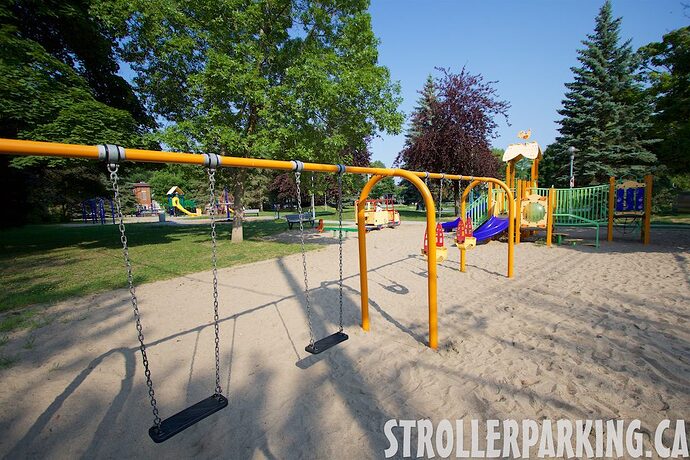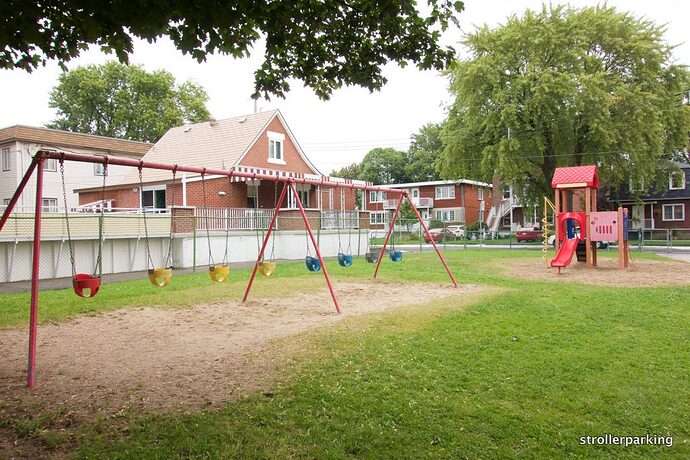This is a sort of high-level, preliminary brainstorming session on my end. I feel like I need input from the community in order to be able to refine it into anything resembling a proposal that can be submitted for comment.
Essentially, I have been micromapping playground equipment recently and have run into a few difficulties. Some of them I have a fairly solid idea of how we could improve them; others, not so much. I would appreciate input!
Inconsistent, sometimes confusing names
One issue I run into while tagging playground equipment is inconsistencies in the naming of the tags, that can make it difficult to find the right one without consulting the wiki page repeatedly.
The first issue is the one of using underscores, versus not using underscores. I struggle to remember which tags do or not not use them, especially when similar tags use different conventions. Examples: climbingwall versus climbing_slope, basketswing versus baby_swing
Another issue is the inconsistent naming of similar devices. basketrotator, aerialrotator, spinner, spinning_disc, spinning_circle, and spinner_bowl are all devices that rotate/spin, but they follow three different naming themes (spinner/spinning/rotator). It would be helpful to have consistency.
Ultimately, I am not familiar with the social history of renaming existing tagging standards, so I only present these frustrations for comment from users who can offer more insight into whether or not restandardization is common or even possible.
One feature: one element — or swings, and their issues
On the wiki page for playground equipment itself, it is indicated that baby=yes|no is a problematic tag. I did not discover this until recently, after tagging many swings with baby=yes when baby seats were present (but not the only type of swing seat available). I had been under the impression that it worked somewhat like a parking lot: where indicating baby=yes implied that there was at least one baby seat, not that the entire swing was for babies.
There exists playground=baby_swing to specifically denote swings that are for babies, and it could be used to tag a section of a swing set, but in my mind this violates the “one feature: one element” convention. As it stands, there is no way to tag a swing set as having multiple different kinds of seats, which is a common configuration.
Other kinds of swing seats also exist, some of which are covered by tags on the existing wiki page, but all of which suffer from the same shortcoming that baby=* does — namely, that they do not clearly denote whether or not they apply to the entire swing set, nor do they denote capacity.
My idea for improving swing tagging is as follows:
- Introduce
capacity:baby=*in addition to the existingcapacity=*to denote the number of baby seats on a swing set. And possibly other tags, for other kinds of seats such as these combined baby+adult ones, or these ones that can securely hold an adult. I would appreciate tag suggestions for these! Wheelchair-accessible swings also exist, and could also possibly benefit from capacity tagging. - Deprecate
playground=baby_swingin favour of the above.
Potentially missing equipment tags
Non-exhaustive list, but some of the things I’ve run into in the past few weeks that I have struggled to tag under the existing system. Happy to have my usage clarified on any of these.
- Acrobatic rings
Definitely a missing tag. These have an equivalent tag in thefitness_stationtag space, but often feature in playgrounds.playground=ringswould seem appropriate. - Wobbly ladders
Ifplayground=wobble_bridgeis distinct fromplayground=bridge, then I believe something similar would be appropriate for ladders. Chain or rope-based ladders are common in playgrounds, and may represent a significant obstacle to some playground users being able to climb the equipment. (Example, left) - Wobbly stepping posts
Maybe this is fine being tagged as a normalstepping_post? (Example) - Rope net bridges
rope_traversedoesn’t feel right for this, nor necessarily doeswobbly_bridge. (Example) - Running wheels
A sort of inverseplayground=hamster_wheelwhere one runs on top of the wheel. (Example) - Halfpipe simulators
By far the coolest and most impossible-to-tag thing I’ve found yet! Hard to explain, so see this video for an example.
- What is defined as a
rope_swingcurrently is very different to what I know as a “rope swing”, which is simply a thick rope hanging from a tree, with either a knot or a small seat at the bottom. I am uncertain as to whether or not to use this tag for this kind of swing.
Element type guidelines
Some types of playground equipment are listed in the wiki as only being suitable for nodes or areas — and subsequently throw errors on iD when you tag them as ways. However, many of these features are commonly in a configuration that would make the most sense to tag as a way, such as this climbingframe that would not make sense as anything but a way. (Actually on second look, climbingframe is approved as a way on the wiki, so this particular case might just need to be entered as a bug report on the iD repo.) Another feature type that comes to mind is platforms, which may be quite long, but differ from bridges in my mind.
Similarly, there are types of playground equipment that give errors when drawn as areas, despite them being large enough to justify it. This large patch of stepping_posts makes sense as an area.
Conclusion
I feel confident in my idea regarding swing capacity tagging, but everything else here is more nebulous. I would very much appreciate any discussion on this topic to help me refine my ideas, and clarify usage of existing tags so I can discard any irrelevant ones!

